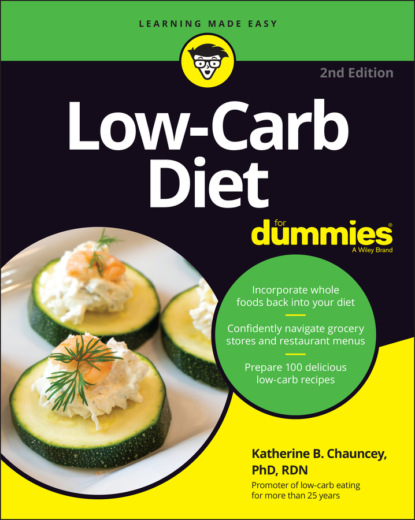fuel. Carbohydrate is everywhere except in meats and animal fats, and most of it is pretty tasty. Carbohydrate as a nutrient source is an important part of a healthy diet. To restrict all dietary intake of carbohydrate, the way some low-carb diets prescribe, regardless of its food source is short-sighted. Dismissing fruits, vegetables, whole grains, and beans simply because they contain carbohydrates can be disastrous to your health, in both the short run and the long run.
The intake of refined carbohydrate foods (foods that have been stripped of their nutritional value during processing), yielding little nutritive value except calories, has overwhelmed this sedentary nation. (For more on this situation, take a look at Chapter 2.) Children and athletes can consume larger amounts of starches and sugars with less harm than can relatively inactive people, but many people tend to eat a greater amount of these kinds of carbohydrates than they can handle. So, before you start to lower your carbohydrate intake, you need to get a sense of the various forms and functions of carbohydrates. This chapter can help you decide which ones to keep and which ones to control.
Understanding Carbohydrates
The primary role of carbohydrates in human nutrition is to supply an indispensable commodity — energy. When carbohydrates yield energy at the rate of 4 calories per gram, they spare proteins from being used for energy so that proteins can do the building and repairing of body tissues that they are uniquely suited for.
Without sufficient carbohydrate, your body will burn its protein for fuel. Carbohydrates appear in virtually all plant foods and in only one food taken from animals — namely, milk. Choosing good sources of carbs can help you control your blood sugar and your weight.
To understand carbohydrates you need to appreciate the various roles they play in the body and the various ways they appear in food. The following sections describe the diverse names and functions of the foodstuffs called carbohydrate.
Identifying the sugar connection
Carbohydrates come in three main sizes:
Monosaccharides: Sugars whose atoms are arranged in a single ring
Disaccharides: Sugars made from pairs of rings
Polysaccharides: Long chains of single-ring carbohydrates
The monosaccharides and disaccharides are known as simple carbohydrates; the polysaccharides are known as complex carbohydrates. Your body almost invariably converts carbohydrates, whatever form they come in (except dietary fibers), to its own energy source, commonly referred to as blood sugar.
What carbs give you beyond nutrition
Six essential nutrients are necessary for good health and for life: protein, carbohydrate, fat, vitamins, minerals, and water. Only protein, carbohydrate, and fat provide energy in the form of calories. Your body needs all these nutrients in order to stay alive. Scientists are discovering, however, that other components are essential for good health. These components don’t yield energy either (in other words, they don’t have calories), but their role in disease prevention is vital. I cover these non-nutrient components in the following sections.
Fiber
Dietary fiber is found in plant foods and is mainly the fiber component of a plant’s cell walls, which aren’t digested by the enzymes in your intestinal tract and, therefore, don’t provide you with any energy. There are two types of dietary fiber:
Soluble: Soluble fiber helps to lower your LDL (“bad”) cholesterol and lowers your rate of glucose absorption.
Insoluble: Insoluble fiber helps to soften your stool and lowers your risk of some kinds of cancer.
As with anything in nutrition, you need a balance of both types of fiber. Each type of fiber performs a distinct function and is necessary for good health. (For specifics on working more fiber into your diet, sneak a peek at Chapter 6.)
EXPLAINING NET CARBS
The concept of net carbs is based on the fact that not all carbohydrates affect the body in the same manner. Fiber is important in calculating net carbs, but fiber doesn’t carry any caloric value. The Nutrition Facts food label lists Total Carbohydrate followed by Dietary Fiber and Total Sugars. The sugars are the natural and added sugars in the food product and are included in the Total Carbohydrate.
For example, if a food has 15 grams of Total Carbohydrate and 6 grams of Dietary Fiber, then subtract the 6 from the 15 to equal 9, which is how much Net Carbohydrate the food has, making it half of a carbohydrate choice. Check out Chapter 6 for more on counting carbohydrate choices and Chapter 9 for more on the Nutrition Facts food label.
Traditionally, soluble fiber got the credit for lowering cholesterol, whereas improvement of bowel regularity was attributed to insoluble fiber. The truth is that both fiber sources improve regularity and lower blood cholesterol.
Phytochemicals
Phytochemicals are compounds that exist naturally in all plant foods (phyto comes from the Greek word for “plant”). Scientists have identified about 10,000 different phytochemicals (or plant chemicals) in the foods you eat, and many still remain unknown. An apple alone has hundreds of phytochemicals. Carbohydrate foods such as fruits, vegetables, grains, legumes, seeds, licorice root, soy, and green tea all contain these plant chemicals. Phytochemicals are best supplied from fruits and vegetables — not from supplements.
Phytochemicals contain protective, disease-preventing compounds. Thousands of different phytochemicals have been identified as components of food, and many more phytochemicals continue to be discovered every day. Just one serving of vegetables gives you more than 100 different phytochemicals. See Chapter 25 for more information on phytochemicals.
Phytochemicals are associated with the prevention and/or treatment of at least four of the leading causes of death in the United States — cancer, diabetes, cardiovascular disease, and hypertension. They’re involved in many processes including those that help prevent cell damage, prevent cancer cell replication, and decrease cholesterol levels.
Table 3-1 lists a few phytochemicals and their sources in carbohydrate foods.
TABLE 3-1 Noteworthy Phytochemicals and Food Sources
| Phytochemical |
|---|
